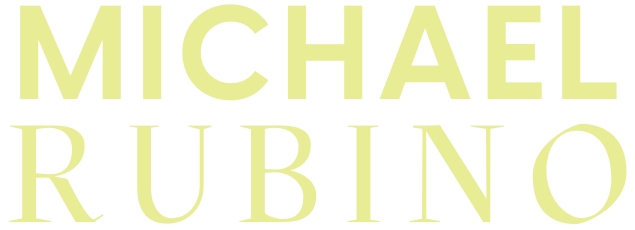Kitchens are known as the heart of a home for a reason. They’re the places families gather to cook, eat meals, and just hang out in to chat. Humans aren’t the only ones that love to gather in these favorited rooms, though. Mold in kitchens can easily turn these happy places into health hazards.
Think of it like Gordon Ramsay’s Kitchen Nightmares but instead of a failing restaurant owner, it’s a mold colonization fiasco causing the problem.

Not all mold growth opportunities occur in visible areas, though. Sometimes mold colonizes hard-to-see, little-thought-of areas. Here are the top 3 hidden locations for mold in kitchens and why this fungus loves your cooking and dining area.
Mold in Kitchens: A Love Affair
Mold is a type of fungus that reproduces by creating microscopic spores that it releases into the air.¹ Similar to the seeds released by a dandelion puff. With over 100,000 species of mold identified so far, it’s easiest to say that mold and its spores exist pretty much everywhere: outside in nature, inside of your car, and even on your favorite sweater. ²
These occurrences don’t typically cause an issue, though! The problem with mold growth arises when it makes your home, its home. As soon as it starts to grow inside, it releases more and more of those spores like confetti out of a confetti gun. That automatically decreases the air quality inside the home (it’s a ton of foreign particles that should not be there) while also allowing for a higher chance that those spores will find another great indoor place to live in and start growing.³
So why the kitchen? It’s filled with all things that mold spores love and need to live! ⁴’⁵ A mold spore only needs four things to survive and thrive.⁶ The first three are easily attainable: oxygen, appropriate temperatures, and food. Obviously, oxygen is an easy checkmark. Most mold spores need temperatures between 40-90 degrees Fahrenheit, which is perfect in a temperature-controlled home, but some can exist in even colder temperatures (like in the fridge).⁷ And finally, they eat pretty much anything, from the drywall to the dust and food particles found all over a kitchen space.
The final ingredient for success is what typically hinders mold growth opportunities: moisture. Mold spores only need 24-48 hours to begin colonizing a space, so if they find even a slightly damp area for that period of time, all bets are off. Which room in a house is often filled with moisture?
Kitchens are! Between cooking, spills, appliances, and running water, the kitchen is overloaded with moisture. These wet surfaces and moisture-rich air make mold in kitchens easily achievable.
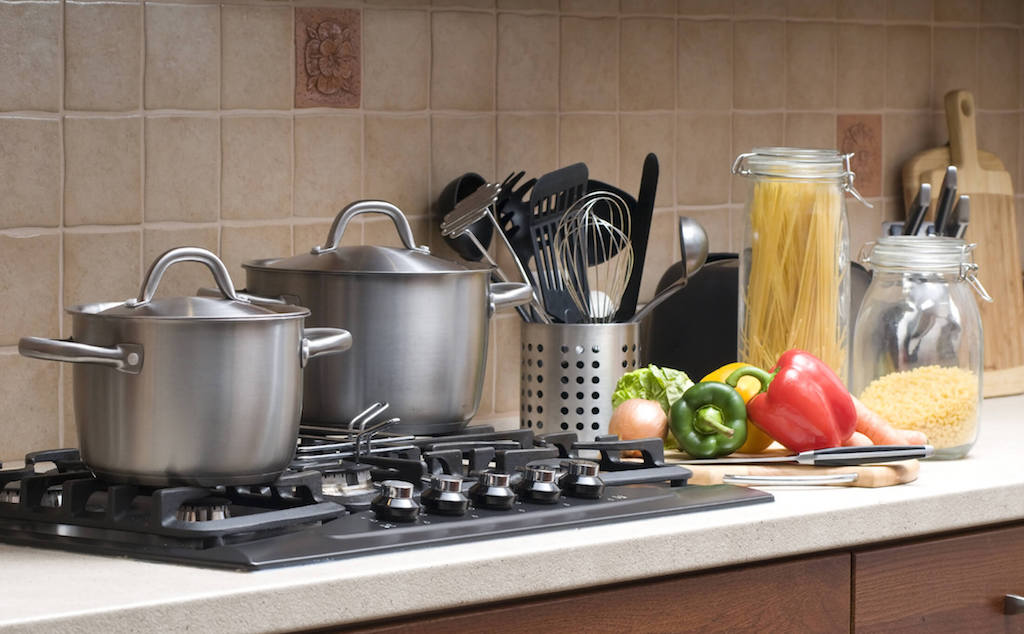
Why Mold Is A Problem
Mold exposure can cause a variety of health issues.⁸’⁹ Researchers are still hard at work attempting to understand exactly how mold exposure affects human health, but most generally agree that it can cause some form of health issues. The difficulty arises from the massive number of species that exist and how every individual is different. Genetics and pre-existing conditions play a huge role in how sensitive people are to mold exposure. For instance, those with compromised or developing immune systems are more likely to experience symptoms quicker and to a greater extent.¹⁰
In a nutshell, the introduction to foreign particles causes the body’s immune system to flare up and react.¹¹ Some species of molds are inherently toxic, but all of them produce spores (aka tiny foreign particles). To make matters more difficult, some species of mold can produce microscopic toxins as well, called mycotoxins.¹² These can also cause a range of health effects in those exposed.
Adverse health effects from mold exposure depend on the sensitivities of the individual, what species and byproducts are present, and the length of time of exposure.

Symptoms of mold exposure range from mildly irritating to severe. These may include:
- Coughing
- Runny nose
- Watery Eyes
- Rash
- Brain Fog
- Chronic Fatigue
- Digestive Issues
- Respiratory Problems
- Neurological issues
The complexity of mold exposure’s effect on health is why it’s better to preemptively stop mold growth and immediately take action once any is found. Checking these top three hidden places for mold in kitchens and taking preventive measures to stop any growth can go a long way towards decreasing moldy opportunities in your home.
Mold In Kitchen Refrigerator Water Spouts
We’ve all probably been told a time or two to drink more water. Got a headache? Drink water. Tired? Drink water! Dry skin? Are you hydrated?
You get the point! This is why the water dispenser in the fridge was such an amazing invention. Cold, crisp, and filtered water is delivered directly into your cup or water bottle in a flash. A lot of them even come equipped with a dual ice machine as well. Ahh, the beauty of ingenuity. The issue is that you’re not the only one that loves your fridge’s water dispenser.
Mold in kitchens can occur in these not-so-visible areas. Between the constant state of wetness, mineral buildup, and random particles from the fridge, cooking, and everyday life, refrigerator water spouts can become moldy dens.
So don’t wait for black specs to start popping up in your water! Not only is it super yucky, but it can also cause serious health problems! Prevention is the name of the game when it comes to keeping these little spouts (as well as the water lines and ice dispensers) free from mold growth.
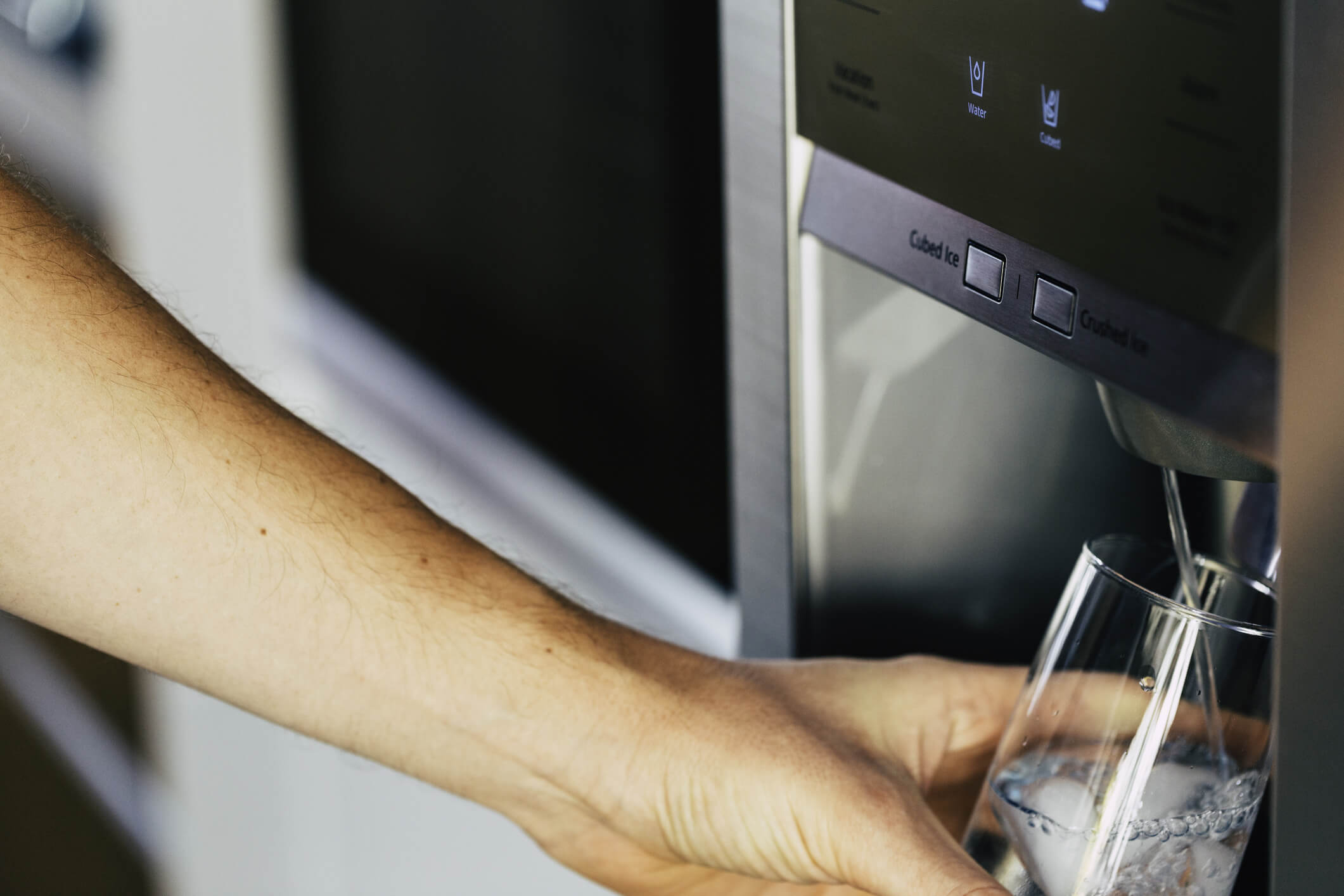
The first step is to check your manufacturer’s manual for a full breakdown of the parts within your fridge’s water dispenser as well as their suggestions for cleaning and maintenance. Replacing the filters as suggested helps prevent any buildup and ensures your machine is running properly, which decreases moldy opportunities.
From there, clean away! Frequently wipe down the outside surfaces using a microfiber cloth and EPA-approved cleaning products. They’re 100 times more effective at wiping away particles. Use a toothbrush dipped in vinegar to scrub the small, hard-to-reach places and a small bristled brush (like a pipe cleaner) for the spout itself. The water tray and any other small removable parts can be tackled during this phase as well. Vinegar is a great tool to use because it’s a descaler, which means it strips away layers of particles from a surface. It’s also antibacterial and antifungal, which helps prevent mold and bacterial growth.
From there, deep cleaning regularly can also help prevent mold growth. That includes the refrigerator’s waterline as well as the ice dispenser and any other removable parts included in the manufacturer’s manual.
Keeping the humidity levels down can also decrease mold in kitchen water dispensers and save you additional fungal headaches, figuratively (depending on sensitivities and symptoms) and metaphorically.
Mold in Kitchen Sink Faucets
We’ve all probably seen some pretty gnarly sink faucets at some point in our lives. Speaking of, when was the last time you took a quick peek at the underneath of your kitchen sink faucet? Whether pink funk or slimy black goo, these bringers of water can become seriously gross and bogged down with mold.
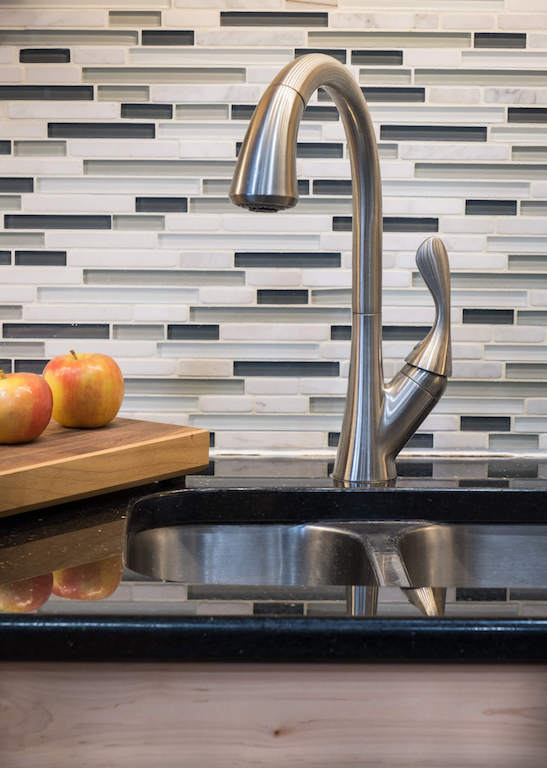
Mold in kitchen sink faucets makes sense when you think about it, though. Between constant use, particles from dirty dishes, potential leaks, mineral buildup from the water, and lack of cleaning (typically), these little areas can become moldy dream homes. While gross to think about, it’s an extra big problem for a few reasons. You’re then washing your hands and dishes with mold. Spores can find their way into the sink’s garbage disposal and begin growing there. Not to mention, mold particles can make their way into your food if you use water from the sink to cook with.
That’s quite a bit of exposure opportunities, which is why it’s important to keep these areas free from mold growth.
To prevent mold growth on your kitchen faucet, cleaning will be your best friend. Wipe down the surface as much as possible to remove particles (at least once a day) using EPA-approved cleaning products. Deep clean the faucet by tying a bag filled with vinegar to it and allowing it to soak. This will break up any mineral buildup that can support mold growth. From there, use a small brush to scrub the faucet head and remove any residue. It’s also never a bad idea to remove the aerator every once in a while to make sure no growth has managed to sneak in and to give it that additional cleaning.
Reducing moisture by continually wiping down surfaces and quickly fixing any leaks also removes growth potential. And once again, keeping humidity levels in the kitchen down can remove wet opportunities.
Mold In Kitchen Cabinets
Whether you’re a Marie Kondo fanatic who loves tidy and organized kitchen cabinets or prefer to chuck things in at random and quickly close the door, mold growth can silently occur inside of these storage spaces.
Mold spores thrive in areas with little ventilation and moisture. When these conditions are inside dark cabinets filled with all kinds of things mold spores eat? Cue paradise trumpets and a choir singing that the perfect home has been found.
Colonization inside cabinets can occur in a few ways, but there are a couple of common culprits. Excess moisture is one, either from high levels of humidity or leaks. The EPA suggests that humidity levels inside of a home remain between 30-50 percent to decrease mold growth opportunities; the "sweet spot," if you will. Kitchens are pumped full of moisture from cooking and running water, which often bumps that moisture content in the air up, allowing spores to maximize and grow. Other watery opportunities, like leaks or flooding of some sort, can also create wet, habitable environments for mold spores.
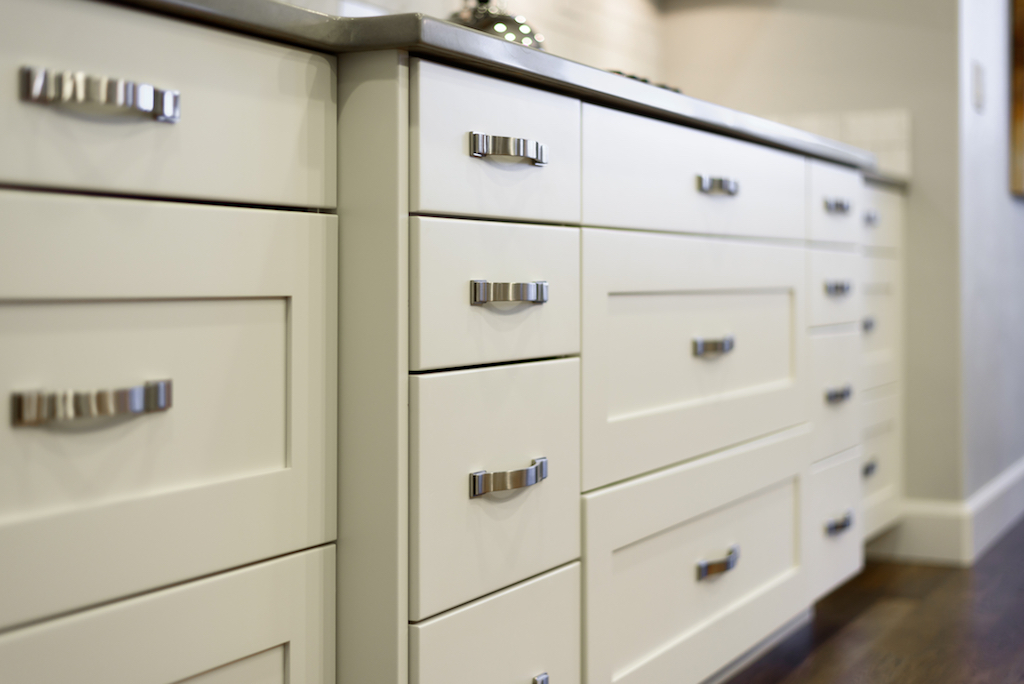
Other issues like lack of cleaning, old food, and improperly dried dishes can also help provide the qualities needed for mold growth in these areas. Growth that may go on for quite a while before you discover the problem.
To prevent mold in kitchen cabinets, regularly clean and assess these areas for issues like leaks or standing water, particularly in cabinets under the sink. Keep wet items out of these poorly ventilated areas, like sponges, damp appliances, and wet dishes. Thoroughly clean all appliances and other items stored in your kitchen cabinets.Make sure to toss out food before it expires and begins to rot. Also, make sure to decrease the humidity in the kitchen as much as possible so these enclosed spaces don’t get inundated in moisture-rich air.
Already Got Mold?
Prevention is the easiest way to keep these areas free from mold growth, but sometimes water events just lead to mold growth. Or, you could decide to add these preventative steps to your cleaning regime, and then boom, you find mold. It can happen to anyone, at any time, in any home!
If you find moldy issues in your kitchen, make sure to address them quickly and properly. If it’s a small problem, that includes using EPA-approved cleaning products and correct cleaning and decontamination protocols. You can check out my ERMI video to learn more about how to contain and mitigate cross-contamination to other rooms in the home. Keep in mind as well, that if bacteria and mycotoxins are present (and they very well may be), cleaning strategies should include measures to remove these particles as well.
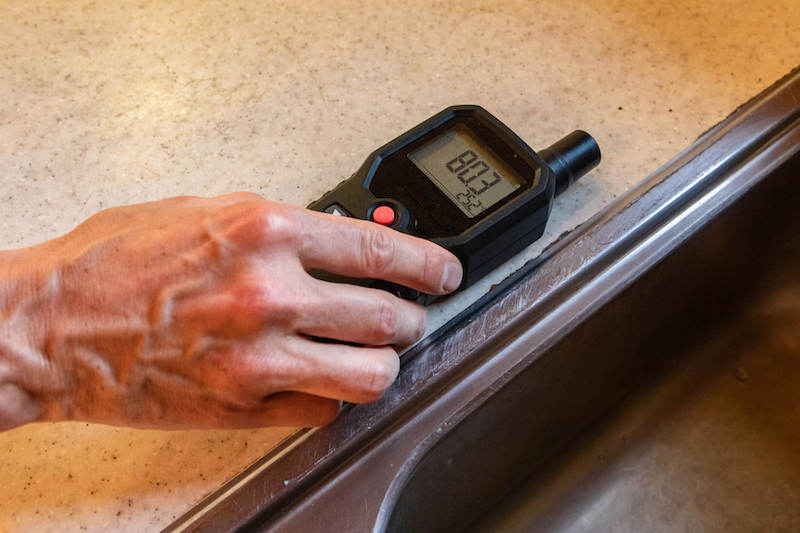
Sometimes, moldy problems require professional help, though. If you find a large mold colony or have quickly recurring mold (which may point to a larger problem), you should consider hiring a qualified mold inspector to come in and assess the problem. They’ll be able to give you an accurate picture of not only the state of your kitchen but also your entire home.
From there, you can hire a remediation company to come in and deal with the problematic area in the kitchen, as well as any other issues the inspector may have found. Keep in mind that not all remediation companies are the same, so make sure to choose a team that has your health as their priority and is equipped to fix the source of the mold in the kitchen as well as all contaminants present.
When in doubt, contact an expert to get their opinion on the situation!
Kicking Mold To The Curb
Whether you’re the family chef, an avid baker, or just love your morning coffee, kitchens probably rank pretty high on your list of favorite rooms in a home. They’re a staple happy place for a reason! That’s why it’s so important to prevent and get rid of mold in kitchens.
While we as a society may not consider mold exposure as a top contender for causing strife in our lives, the truth is that it can be a silent culprit. Growing right alongside us and our families as we go about our morning routine or cook food for Sunday night football. Not exactly the dinner guest we’re looking for. Actively paying attention to these hidden areas mold spores love can help keep our kitchens safe, clean, and free from mold colonization.
(Insert chef’s kiss here)! It’s one small step to discourage mold growth, one giant leap towards improving indoor air quality.
- Environmental Protection Agency. (n.d.). Mold. EPA. Retrieved August 17, 2021, from https://www.epa.gov/mold.
- Centers for Disease Control and Prevention. (2020, August 11). Basic facts about mold and dampness. Centers for Disease Control and Prevention. Retrieved August 17, 2021, from https://www.cdc.gov/mold/faqs.htm.
- Adan, O. C., & Samson, R. A. (Eds.). (2011). Fundamentals of mold growth in indoor environments and strategies for healthy living. Springer.
- Mentese, S., Arisoy, M., Rad, A. Y., & Güllü, G. (2009). Bacteria and fungi levels in various indoor and outdoor environments in Ankara, Turkey. Clean–Soil, Air, Water, 37(6), 487-493.
- Piecková, E. (2016). Domestic environment: Indoor mycobiota as a public health risk factor. In Environmental Mycology in Public Health (pp. 129-146). Academic Press.
- Food Safety and Inspection Service. (2013, August 22). Molds on Food: Are They Dangerous? United States Department of Agriculture . Retrieved October 19, 2021, from https://www.fsis.usda.gov/food-safety/safe-food-handling-and-preparation/food-safety-basics/molds-food-are-they-dangerous.
- Lstiburek, J., Brennan, T., & Yost, N. (2002, January 15). Rr-0208: What you need to know about mold. Building Science Corporation. Retrieved August 18, 2021, from https://www.buildingscience.com/documents/reports/rr-0208-what-you-need-to-know-about-mold/view.
- Bush, R. K., Portnoy, J. M., Saxon, A., Terr, A. I., & Wood, R. A. (2006). The medical effects of mold exposure. Journal of Allergy and Clinical Immunology, 117(2), 326-333
- Environmental and Occupational Health Assessment Program, & Environmental and Occupational Health Assessment Program, & Health Science Section, Mold Basics for Primary Care Clinicians (2009). Hartford, CT; Connecticut Department of Public Health. , H. S. S., Mold Basics for Primary Care Clinicians 1–10 (2009). Hartford, CT; Connecticut Department of Public Health.
- Curtis, L., Lieberman, A., Stark, M., Rea, W., & Vetter, M. (2004). Adverse health effects of indoor molds. Journal of Nutritional & Environmental Medicine, 14(3), 261-274.
- Kim, K. H., Kabir, E., & Kabir, S. (2015). A review on the human health impact of airborne particulate matter. Environment international, 74, 136-143
- World Health Organization. (n.d.). Mycotoxins. World Health Organization. Retrieved August 26, 2021, from https://www.who.int/news-room/fact-sheets/detail/mycotoxins.
